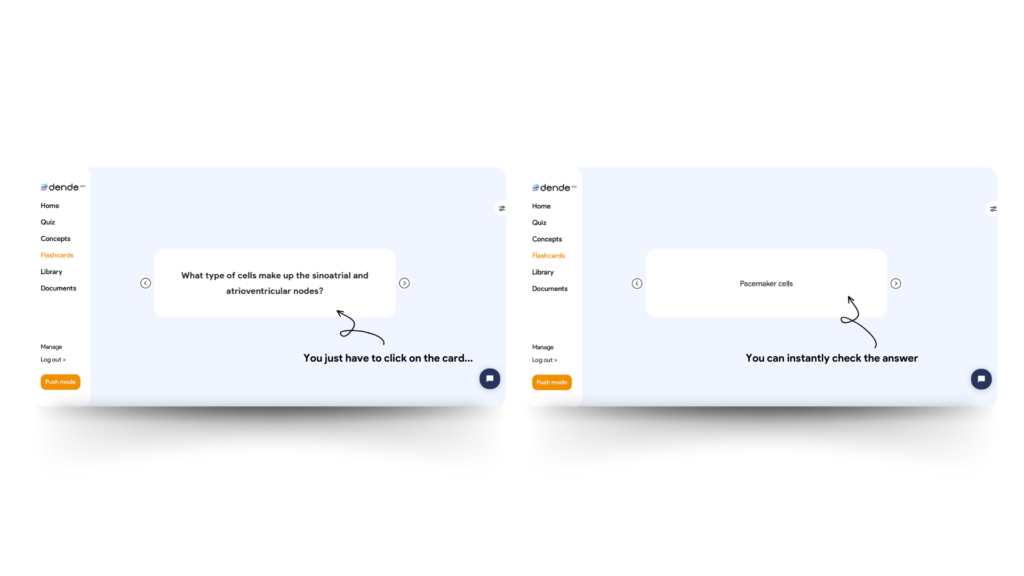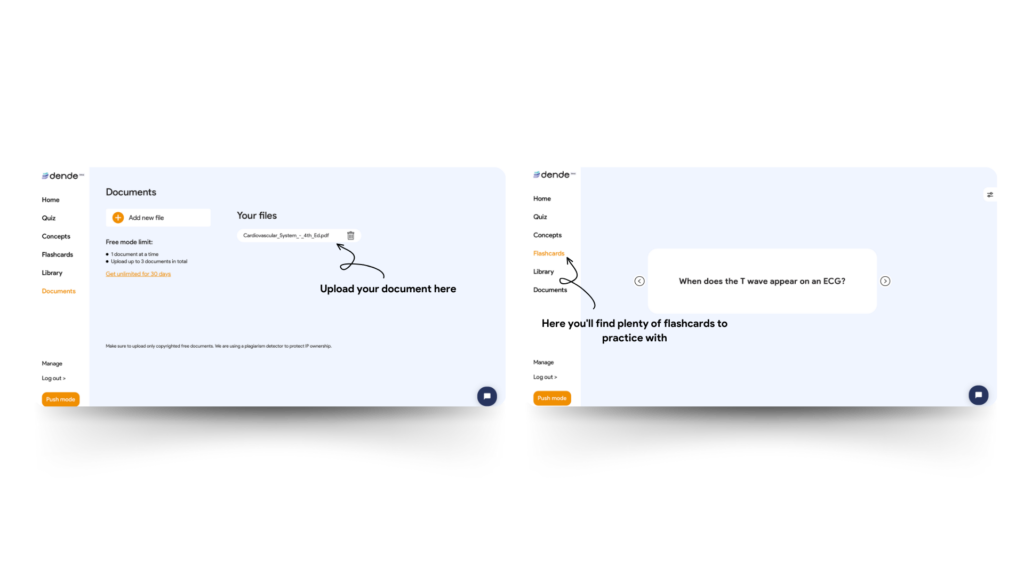
Share with your student friends
ShareGet ready for your next exam
Start for freeWe all know that feeling. We spend long hours studying, desperately trying to cover everything in preparation for exams, only to feel that we are not making any progress.
Let’s find out these 7 effective study techniques for exam preparation in 2024!
Contents
1. Spaced repetition techniques to pass exams better and easier
Spaced repetition is a study technique where you review stuff at intervals instead of cramming it all at once. You know how sometimes you study for a test and then forget everything right after?
Well, spaced repetition helps you remember stuff better by spacing out your review sessions over time.
Here are some recommended optimal spaced repetition intervals:
- 1st repetition: 1 day after the initial learning session
- 2nd repetition: 7 days after the initial learning session
- 3rd repetition: 16 days after the initial learning session
- 4th repetition: 35 days after the initial learning session
However, what’s particularly interesting is that you can organize the spaced repetition in different ways:
- Micro level (facts and concepts): you can use online tools, such as dende (where you can create your own flashcards), so you can submit and re-submit flashcards at increasing intervals, based on your ease of memorization.

Open a flashcards, try to answer, and then, with one click, you can check what you remembered and what you didn’t
- Macro (topics)
At the end of a day of classes, take a moment to summarize what you’ve learned.
Anything you think is important to go over again the next day, write it down in a separate section called “Daily reviews”.
The next day, go through the topics you listed in the “Daily Reviews” section. If you think something deserves more attention, move it over to the “Weekly Reviews” section.
This way, you’ll revisit it about a week later, following the same process (moving some topics to the “Monthly reviews” column and so on).
Some smaller topics will be grouped into larger topics as you move toward more and more delayed repetitions.
2. Best ways to study with flashcards
Studying doesn’t have to be hard work—it can be an exciting and interactive experience, especially when you harness the power of flashcards.
- Turn flashcards into a team game
I get it, study groups can often turn into a productivity black hole. It can be a full-time job just to keep all members focused, right?
Usually, it feels like one or two people end up doing all the heavy lifting, while the others just go the extra mile.
But flashcards can change the game! Picture this: you and a couple of classmates quizzing each other with flashcards.
Suddenly it’s your turn to answer the questions: it’s like a mini-exam, but with your friends.
Dealing with nervousness during study sessions can help calm pre-exam jitters.
It’s quite a change for those who usually study solo in silence. Just remember to stay on task, even if you’re joking with your BFF in between questions.
Trust me, it’s all about finding that balance between focus and fun.
- Create a deck of flashcards specifically for brain dumps
Brain dumps are a great way to test the amount of information you can recall on demand.
Here’s how to do it: you sit down with a blank sheet of paper, set a timer and simply write down everything you can remember about a particular topic.
I recommend doing this exercise once a week with a couple of concepts you’re working on.

You can use a deck of flashcards specifically for this process. Simply shuffle the deck and choose a few cards at random.
Then, dive into your brain dump session using those selected flashcards as your prompts.
By picking concepts randomly like this, you keep things fair and square. There’s no cherry-picking the easy stuff—you’re forced to tackle whatever comes up, whether you’re super comfy with it or not.
This helps reinforce those mental connections and pushes review to topics that need extra attention.
- Use flashcards…backwards!
Once you have memorized a set of flashcards, try testing yourself by flipping them over and reviewing the solutions. It’s a clever way to ensure you truly understand and work with the concepts, rather than just memorizing the cards.
By flipping the deck over and trying to guess the question from the answer, you’re reinforcing mental connections in both directions. This exercise strengthens these pathways, ensuring your understanding isn’t one-sided.
Want to see if you can match terms to their definitions? Well, you won’t find out until you flip the paper over and give it a shot! It’s all about challenging yourself and deepening your understanding of the material.
3. How to use active recall in your study routine
Instead of rereading or rewatching material, active recall requires you to actively engage with the information by attempting to recall it from memory.

Let’s take a look at how to integrate active recall into your study routine:
- Before learning
A useful approach to active recall is to test yourself before a lesson begins. When we learn something new, we connect it to what we already know.
Therefore, it’s helpful to briefly review what we already understand to lighten the mental load. Before starting a new study session or class, revisiting what you’ve previously studied activates your prior knowledge.
This makes it easier to link new information to what you’ve already learned.
- During learning
When engaging with content such as slides, videos, or books, it’s common to adopt a passive approach, thinking you are learning.
A more effective method involves employing an active recall technique that we can call the “closed book” method.
When reading, after completing each paragraph or section, close the book or cover the material you’ve just read and attempt to explain it without referring back. Upon completion, revisit the material to verify your comprehension.
This method encourages a natural segmentation of the material into smaller chunks by incorporating pauses. Moreover, by articulating the content in your own words, you reinforce your learning process, ensuring comprehension as you progress.
- After learning
Now that you’re at this stage, there are a lot of ways you can use active recall.
For instance, you could try making a mind map. It’s not just about what you know about the topic—it’s also about figuring out how everything fits together.
Another fun option is to pretend you’re teaching someone else. Explaining the topic to yourself or a classmate forces you to really remember it, which helps you learn better.
4. Multiple choice test taking strategies
It may seem pretty obvious: studying, practicing and going to class are some of the best ways to make sure you do well on multiple choice tests.
But did you know that there are also in-test strategies?

Did you know that dende gives you immediate feedback? It tells you why you were wrong and you can immediately see the correct answer
- Look for patterns or clues: pay attention to patterns or clues in the questions and answers. Sometimes, the wording or structure of the question can hint at the correct answer. Similarly, look for cues in the options that may guide you to the correct choice.
- Use contextual clues: consider the context of the question and use it to guide your answer. Sometimes, information provided in other parts of the test or in the question itself can help you infer the correct answer, even if you’re unsure of the specific details.
- Be wary of absolute terms: be cautious of options that include absolute terms like “always,” “never,” or “all.” These terms often indicate an extreme statement and, in many cases, an oversimplification.
- Focus on key terms: pay close attention to key terms or phrases in both the question and the answers. Sometimes, matching these key terms can lead you to the correct answer more easily.
- Watch for qualifiers: look out for qualifiers such as “most,” “often,” “usually,” or “sometimes.” These qualifiers can significantly change the meaning of an option and may indicate the correct answer.
- Trust your gut: if you’ve studied well and feel confident about an answer, trust your intuition. Avoid second-guessing yourself excessively, as this can lead to overthinking and potentially choosing the wrong answer.
5. The Pomodoro technique – why it works and how to do it
The Pomodoro technique is a time management trick to help you study. It’s all about slicing up your work into chunks, usually around 25 minutes long, and taking quick breaks in between.

Let’s say you’re studying anatomy for an upcoming exam. Here’s how you could apply the Pomodoro Technique:
- Set your timer: begin by setting a timer for 25 minutes
- Study: use this 25-minute interval to focus exclusively on studying a specific topic in anatomy, such as the skeletal system or the digestive system.
- Take a short break: when the timer goes off, take a short 5-minute break. Use this time to stretch, walk around, or grab a drink to refresh your mind and body.
- Resume studying: start another Pomodoro session by setting the timer for another 25 minutes. Dive back into your study material and continue learning.
- Repeat the cycle: continue this cycle of focused study sessions followed by short breaks. Aim to complete four Pomodoros (or two hours) of focused study before taking a longer break.
Why does it work so well? Well, it helps you really zone in on your work and get stuff done by breaking it into manageable pieces. Plus, those little breaks keep your brain fresh and ready to tackle the next task.
6. Review, review, review: mind mapping techniques
Mind mapping is a fun and effective way to visually review information. Instead of jotting down notes in a list, you create a diagram that shows how ideas, concepts, and information are connected

One of the cool things about mind mapping is that it gets both sides of your brain working together. This helps you think more creatively and remember things better.
Now, let’s talk about two popular types of mind maps:
- Spider diagrams: these are like traditional mind maps but with a twist. You start with a main idea in the center and then branch out in a circular or radial pattern. Each branch represents a related idea, and you can keep adding more branches as needed.
- Tree diagrams: picture a family tree, but for information. The main idea sits at the top, and then you have branches extending downwards to show subtopics or related concepts.
These branches can keep dividing into smaller branches, kind of like how a tree grows leaves. Tree diagrams are great for organizing data, outlining processes, and showing how things are structured.
7. Take breaks (yes, this is also a study technique!)
Yes, it is: taking breaks is a study technique! It plays a significant role in maintaining concentration, improving productivity, and preventing burnout.
Although it may seem counter-intuitive, stepping away from study material at regular intervals allows your brain to rest and recharge.
By incorporating short breaks into your study sessions, you can maintain high levels of concentration while also relaxing and reducing stress.
What can you do during these breaks? Some jogging or meditation, coffee with fellow students, or… just a short rest!
So, now you are ready for your next study session! Log in and start your next exam preparation run.
